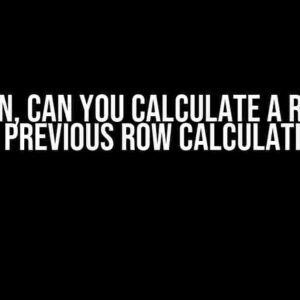Are you tired of dealing with the unpredictability of CTkLabel widths? Do you find yourself constantly Googling for solutions, only to come up empty-handed? Fear not, dear reader, for today we’re about to embark on a journey to uncover the secrets of CTkLabel width detection. Buckle up, because we’re about to dive into the world of Python, Tkinter, and CTk widgets!
The Problem Statement
When working with CTk widgets, particularly CTkLabels, it’s not uncommon to encounter issues related to width calculation. By default, CTkLabels use a dynamic width that adjusts to the content size, making it challenging to determine the exact width. This can lead to layout issues, overlapping widgets, and a general sense of frustration.
Why Do We Need to Find the Exact Width?
Knowing the exact width of a CTkLabel is crucial for various reasons:
- Layout Management**: Accurate width detection helps you create a well-structured and balanced layout, ensuring your application looks professional and visually appealing.
- Widget Placement**: By knowing the exact width, you can precisely place other widgets around the CTkLabel, preventing overlaps and layout mishaps.
- Responsive Design**: In cases where your application needs to adapt to different screen sizes or resolutions, knowing the CTkLabel width helps you create a responsive design that works seamlessly across various devices.
The Quest for the Perfect Solution
After thorough research and experimentation, we’ve uncovered a few methods to find the exact width of a CTkLabel. Buckle up, because we’re about to explore these solutions in-depth!
Method 1: Using the `winfo_reqwidth()` Method
The `winfo_reqwidth()` method is a built-in Tkinter function that returns the requested width of a widget. This method can be used to find the exact width of a CTkLabel:
import tkinter as tk
from customtkinter import CTk
root = tk.Tk()
ctk_label = CTk.CTkLabel(root, text="This is a CTkLabel")
ctk_label.pack()
width = ctk_label.winfo_reqwidth()
print("CTkLabel width:", width)While this method seems straightforward, it has some limitations. In certain scenarios, `winfo_reqwidth()` might return an incorrect value or 1 (the default width), especially when the CTkLabel contains text with varying font sizes or styles.
Method 2: Using the `font_metrics()` Method
The `font_metrics()` method, part of the Tkinter `Font` class, provides information about the font metrics, including the width of a given text. We can leverage this method to calculate the exact width of a CTkLabel:
import tkinter as tk
from customtkinter import CTk
from tkinter.font import Font
root = tk.Tk()
ctk_label = CTk.CTkLabel(root, text="This is a CTkLabel")
ctk_label.pack()
font = Font(family=ctk_label.cget("font")[0], size=ctk_label.cget("font")[1])
width = font.measure(ctk_label.cget("text"))
print("CTkLabel width:", width)This method is more accurate than `winfo_reqwidth()`, but it still has some limitations. For example, it doesn’t account for the CTkLabel’s padding, borders, or other styles that might affect the overall width.
Method 3: Using a Custom Solution
For more complex scenarios or when the above methods fail, we can create a custom solution to calculate the exact width of a CTkLabel:
import tkinter as tk
from customtkinter import CTk
root = tk.Tk()
ctk_label = CTk.CTkLabel(root, text="This is a CTkLabel")
ctk_label.pack()
# Create a temporary label to measure the width
temp_label = tk.Label(root, text=ctk_label.cget("text"), font=ctk_label.cget("font"))
temp_label.pack()
# Get the width of the temporary label
width = temp_label.winfo_reqwidth()
# Destroy the temporary label
temp_label.destroy()
print("CTkLabel width:", width)This custom solution creates a temporary label with the same text and font as the CTkLabel, measures its width, and then destroys the temporary label. This approach is more reliable and accurate, but it might be overkill for simple use cases.
Conclusion
In conclusion, finding the exact width of a CTkLabel can be a challenging task, but with the right approaches, you can overcome this hurdle. By using the `winfo_reqwidth()` method, the `font_metrics()` method, or a custom solution, you can accurately determine the width of a CTkLabel and create visually appealing, responsive, and professional-looking applications.
Best Practices
To ensure accurate width detection, follow these best practices:
- Use a consistent font and font size across your application to simplify width calculation.
- Avoid using dynamic widths for CTkLabels, as they can lead to unpredictable behavior.
- Test different scenarios to ensure your width detection method works across various screen sizes, resolutions, and devices.
By following these guidelines and using the methods outlined in this article, you’ll be well on your way to creating stunning applications with precision-placed widgets and flawless layouts.
| Method | Description | Accuracy |
|---|---|---|
| winfo_reqwidth() | Returns the requested width of a widget | Moderate |
| font_metrics() | Provides font metrics, including text width | High |
| Custom Solution | Creates a temporary label to measure width | Very High |
Now that you’ve mastered the art of finding the exact width of a CTkLabel, go forth and create amazing applications that impress and delight your users!
Here are 5 Questions and Answers about “How can I find the exact width of a CTkLabel?” :
Frequently Asked Question
Get the inside scoop on finding the exact width of a CTkLabel with these frequently asked questions!
Q1: Can I simply use the `width` attribute to get the exact width of a CTkLabel?
Unfortunately, no! The `width` attribute only sets the minimum width of the label, not the exact width. You’ll need to use a more precise method to get the exact width.
Q2: How can I use the `winfo_width()` method to get the exact width of a CTkLabel?
You can use the `winfo_width()` method, but only after the label has been displayed on the screen using the `update_idletasks()` method. This ensures that the label has been laid out and its width has been calculated.
Q3: What if I want to get the exact width of a CTkLabel before it’s displayed on the screen?
In that case, you can use a temporary window and the `winfo_reqwidth()` method to get the requested width of the label, which is usually the exact width you’re looking for.
Q4: Will the `winfo_width()` method give me the exact width of a CTkLabel, including any padding or borders?
No, the `winfo_width()` method only returns the width of the label’s content area, excluding any padding or borders. If you need to include those, you’ll need to add them to the width manually.
Q5: Are there any other ways to get the exact width of a CTkLabel, besides using the `winfo_width()` method?
Yes, you can use the `place_slaves()` method to get the width of the label, or even create a custom method using the `winfo_geometry()` method and some mathematical calculations. But `winfo_width()` is usually the most straightforward way to go!



